Belief in the Premodern Period
For the medieval period, much of Europe was Christian, but some areas were only converted gradually, and minority groups such as Jews and Muslims remained in areas. With the Protestant Reformation that began in 1517 with Martin Luther's Ninety-Five Theses (with other significant reformers being Jean Calvin and Philip Melanchthon), Christian Europe began to fragment into Catholic and Protestant. Protestants would split into many fragments, including radical elements. The Reformation would come to England between 1529-1537 under Henry VIII, and is a focus of many of the works below.
John Jewel (1522-1571)
A Defense of the Apology of the Church of England; containing an answer to a certain book lately set forth by M. Hardinge, and entitled, A confutation of etc. Whereunto there is also newly added an answer unto an other like book, written by the said M. Hardinge, entitled, A detection of sundry foul errors etc., printed at Louaine, anno 1568.
London, 1571
Adoption Price: $100
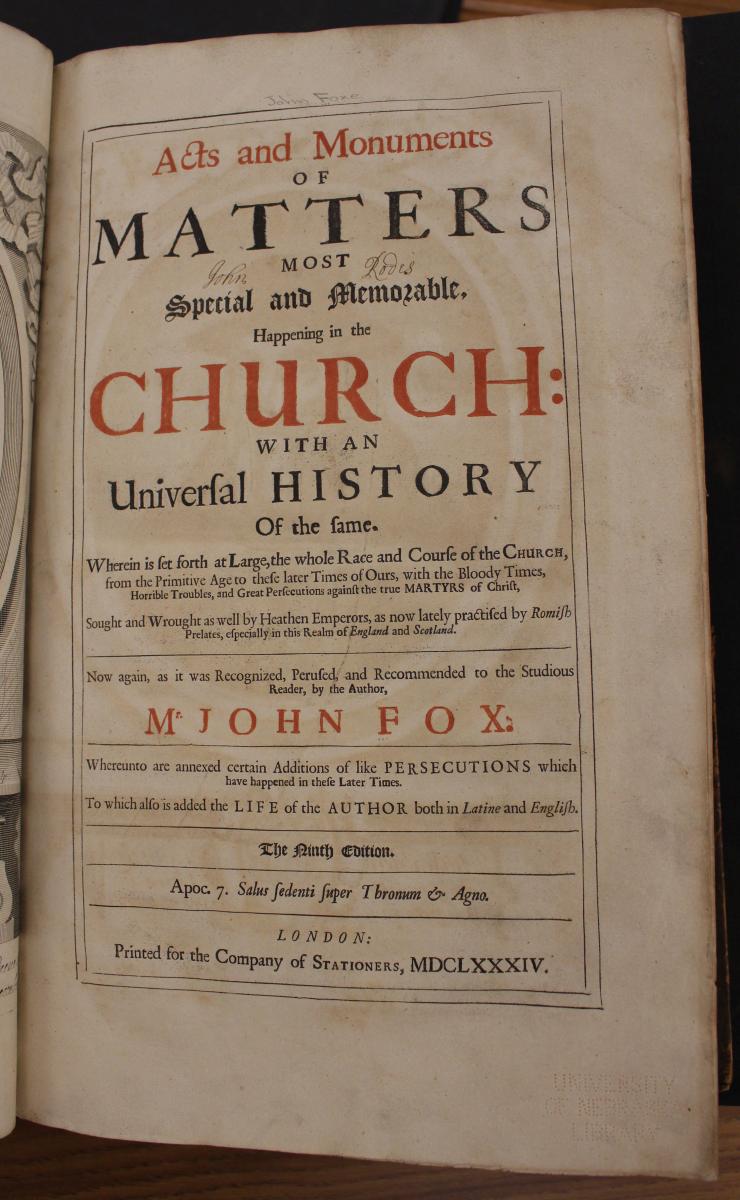
Author: John Foxe (1516-1587)
Acts and Monuments of matters most special and memorable, happening in the church
Other Title: The Book of Martyrs
London : Printed for the Company of Stationers, 1684
Note: three volumes
Adoption Price: $250, each volume
Author: Henry Wilkinson (1610-1675)
A sermon against lukewarmness in religion: preached at Saint Mary's in Oxford, the sixth of September, 1640
printed 1641
Description: Henry Wilkinson (1610-1675) was a Church of England clergyman who had Puritan tendencies. In Oxford in 1640, he delivered this controversial sermon that called for religious zealotry and claimed the Scot’s victory at Newcastle as God’s punishment for England’s lack of this zealotry. While he was initially forced to give up his role at the university because of this sermon, he eventually won the approval of Parliament and had this sermon published at their request in 1645. This sermon and the controversies around it show the religious fervor during the Civil War and how politics influenced whether such religious ideas would be suppressed or encouraged. The text itself includes intricately designed drop caps, patterned chapter heads, and marginalia that is mostly Scripture verses. -- Kathleen Kokensparger
Adoption Price: $25
ADOPTED!
Author: Gilbert Burnet (1643-1715)
The history of the reformation of the Church of England : in two parts
London : Printed by T.H. for Richard Chiswell at the Rose and Crown in St. Paul's church-year, MDCLXXXI (1681-1683)
Description: Gilbert Burnet, a Scottish philosopher and historian, offers a rebuttal of Nicholas Sanders’ criticism on the English Reformation, which claimed that it was all a political act carried out by a corrupt king. In 1679 Burnet published The History of the Reformation of the Church of England (vol. 1) which focused on the reign of the Tudor monarch King Henry VIII. In 1681 Burnet then published the second volume, which continued this discussion into the reign of Henry’s youngest daughter Queen Elizabeth I. Although Catholics disputed the content, these published works became a hallmark for Burnet’s career, and he was awarded Doctor of Divinity in 1680 from the University of Oxford. Because these were published during the reign of Roman Catholic monarch King James of England and Ireland II & King of Scotland VII, this offers an interesting look in religious factionalism in England. The volumes refute Sanders’ claims and promote the Reformation of England which offers a fascinating insight as to how contemporary historians dealt with national factionalism and religious dissent, and how a member of the Church of England thrived under a Catholic monarch and how these publications helped shaped England’s national identity. -- Emily Schmidt
Note: two volumes
Adoption Price: $25, each volume
Author: John Strype (1643-1737)
Annals of the Reformation and establishment of religion, and other various occurrences in the Church of England, during the first twelve years of Queen Elizabeth's happy reign ... Compiled faithfully out of papers of state, authentick records, publick registers, private letters and other manuscripts.
London, Printed by, and for, T. Edlin, 1725-31
Note: two volumes
Adoption Price: $100, each
Volume 1 ADOPTED!
Author: G.B.C.
Plots, Conspiracies, and attempts of domestic and foreign enemies of the Romish religion, against the princes and kingdoms of England, Scotland and Ireland. Beginning with the reformation of religion under Queen Elizabeth, unto this present year, 1642.
Printed for Ralph Rounthwait, 1642
Description: This 1642 work is of unknown authorship; it is “Collected by GBC” and printed for Ralph Rounthwait, who appears to have owned a book shop in Paul’s Churchyard in London. While the title boasts that this book covers plots through to 1642, it deals mostly with plots against Queen Elizabeth, with only a few plots threatening James I and Charles I. The work is concerned with Catholic plots, particularly by the Spanish. Even domestic plots, such as a squire’s attempt to poison the queen’s saddle, are the result of involvement by the Spanish, and the Jesuits in particular. Many of these plots are connected to Phillip II’s marriage to Mary I and the denial of a marriage between him and Elizabeth I. This work reveals a continuing anti-Spanish and anti-Catholic sentiment well into the Stuart era, as well as a continuing interest in the intrigues of the Elizabethan era. The book itself is very short, and is made even shorter by having 3 pages missing. -- Kathleen Kokensparger
Adoption Price: $25
ADOPTED!
Author: Jeremy Taylor (1613-1667)
A discourse of the liberty of prophesying : shewing the unreasonableness of prescribing to other men's faith, and the iniquity of persecuting differing opinions
London : Printed for R. Royston, at the Angel in Ivie-lane, 1647
Description: Jeremy Taylor was a cleric for the Church of England during the 17th century. He gained traction as a diligent student, receiving his BA and MA from Cambridge. He got a professional start as a prose writer under the patronage of William Laud, Archbishop of Canterbury. He later became chaplain to King Charles I due to Laud. Due to Laud’s patronage, however, he was met will hostility during the English Civil War. He survived, unlike Laud, and later became Bishop of Ulster in the Restoration. Taylor married twice, once being to Joanna Brydges, the daughter of Charles I and Miss Brydges.
The book is not written with sections or even a table of contents, though later editions do have them. It is almost like one long tract of information. However, some enterprising owner wrote into the front cover of the book at very highly detailed table of contents to describe where specific sections are. It is thought that the work may have once had a table of contents, due to the similarities of the written table in the front cover in comparison to those found in later editions. This is thought to be done either by Nathanaelis Dod or Sam Cooper, who have both elaborately signed the book. Owners have also left signatures in the back cover as well. One of these owners has written a dedication or small abstract of the book, but further investigation with certain skills is needed on this. The work begins with an elaborate illustration that is written with Greek.
The book is feels very water damaged, but does not show it. The 267-page work’s pages are rippled, and feel as if they have been dried after living in strong moisture for a long time. The edges of all the pages are splashed with red ink, as if someone dropped an ink well next to the pages and it splattered through them. It is a relatively small book, approximately 4 inches by 5 inches, at most. -- Andrew Singleton
Adoption Price: $25
ADOPTED!
William Laud (1573-1645)
The history of the troubles and trial of the most reverend father in God, and blessed martyr, William Laud, Lord Archbishop of Canterbury. Wrote by himself, during his imprisonment in the Tower. To which is prefixed the diary of his own life faithfully and entirely published from the original copy: and subjoined a supplement to the preceding history: the arch-bishop's last will; his large answer to the Lord Say's speech concerning liturgies; his annual accounts of his province delivered to the King; and some other things relating to the history
London, Printed for Richard Chiswell, (1695)-1700
Note: two volumes
Adoption Price: $25, each
Volume 1 ADOPTED!
Author: Peter Heylyn (1600-1662)
The history of that most famous saint and soldier of Christ Jesus, St. George of Cappadocia : asserted from the fictions of the middle ages of the church, and opposition of the present : the institution of the most noble Order of St. George, named the Garter : a catalog of all the knights thereof until this present
London, Printed for Henry Seyle, and are to be sold at his shop ..., 1631
Note: spine title: Heylin's history of St. George 1631; with signature of William Brereton on preliminary page and bookplate of Charles N. Dietz on front paste-down; bound in blind tooled leather with blue wooden case
Adoption Price: $50
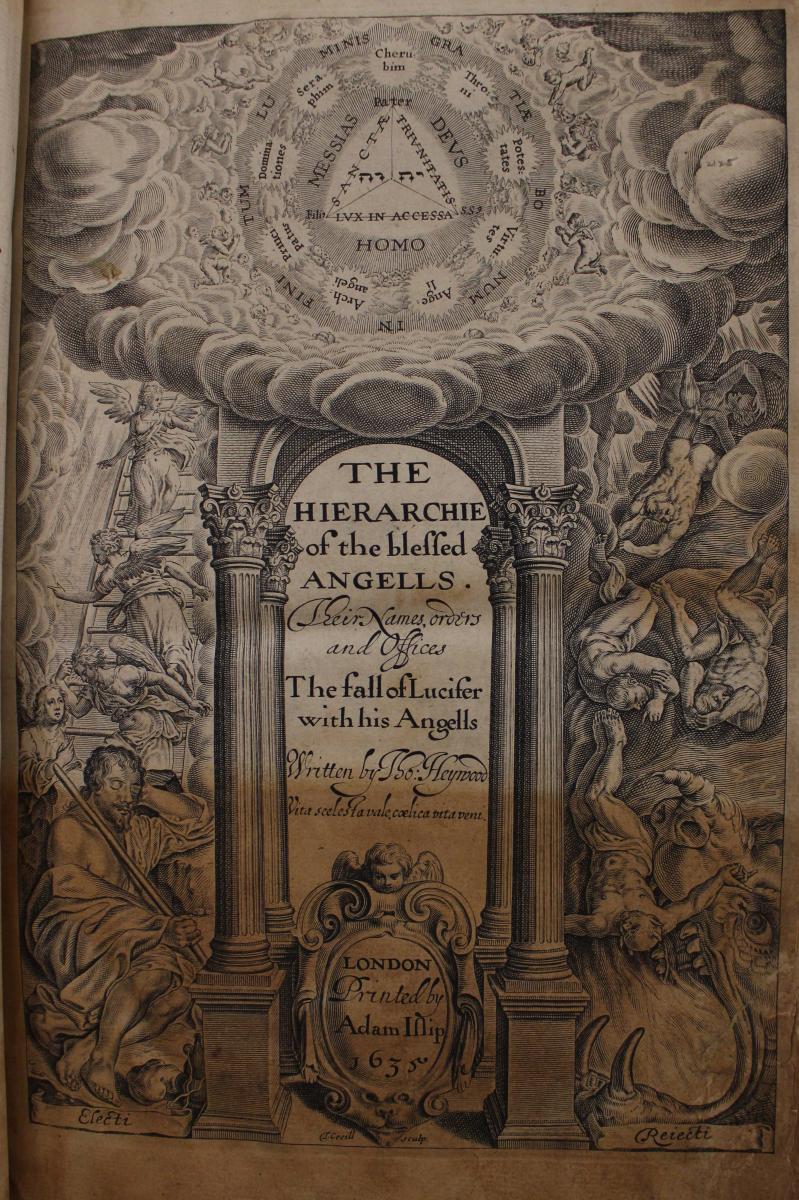
Author: Thomas Heywood
The hierarchy of the blessed angels. Their names, orders and offices. The fall of Lucifer with his angels.
London, Printed by Adam Islip, 1635
Description: Thomas Heywood was an English playwright and author from the late Elizabethan/early Jacobean ages. The writer has over 20 attributed works to his name, most of which are in prose. He is most known for his prose writing and was compared to Shakespeare in that regard. He is said to have died around August 16, 1641, which is his burial date and only known date of the kind.
The book is a mixture of poetic prose and theological writings, split in 9 parts. Because of this, the length of every bit of writing can range from short to very long, depending on the subject matter. The evidence of such can be seen in the physical descriptions of the archangels compared to their duties and powers. To fill up space left by those small entries, very elaborate engraved plates of angels and angelic ideas are printed on full length pages. The size of these make for very appealable representations and aspects of them have shown up in later writings and works. The margin talk is at times more elaborate than the principle writing. Each owner has seemingly signed their name to the front cover of the book, making roughly ten owners known. One writer has, what looks to be, written a small section of writing in the cover, as well.
While the topic of angels has been theologically well extrapolated by writers like St. Thomas of Aquinas, it has never stopped being a topic of fascination. This work is summation of the works of the greater writers in an easily digestible manner. It would have allowed readers of the Elizabethan and Jacobean periods the ability to grow their understanding of angels to be used when they are reading the bible. Furthermore, the book has wonderful illustrations to further the understanding of the reader or give them something to use to make a visual concept image. The work is best used to understand the English reader of the periods, as well as the concepts being thrown around religiously in respect to angels and hell.
The 622-page work is in relatively good outside condition. The binding has survived the course of time. However, the parchment is another situation. Due to either age or by printing, the pages are very thin and fragile. It is worrisome when flipping some pages, given their fragility. The water damage to the pages should also be taken into consideration. This situation, however, has not decreased the quality of the writing or plate illustrations. With preservation and careful handling, this work could be seen by people. -- Andrew Singleton
Note: A poem in 9 books, each preceded by an argument in verse and an engraved plate, and followed by observations in prose and "A meditation" in verse. Includes a celebrated reference to Shakespeare and his contemporaries (Book IV, p. 206) and some curious stories concerning witches, magicians and ghosts
Adoption Price: $50
ADOPTED!
Author: Pope Gregory I (c.540-604)
In comincia i libro delle omelie di sancto Gregorio papa di diuerse lectioni del sancto euangelio. Mandate a fecondi no uesco uo
Firenze, 1502
Adoption Price: $100
ADOPTED!
Author: Saint Augustine, Bishop of Hippo (354-430)
S. Augustine's Manuel, or little book of the contemplation of Christ, or of God's word, whereby the remembrance of the heavenly desires which is fallen asleep may be quickened up again
London: printed by Iohn Wolfe, for the Assignes of Richard Day, 1586
Adoption Price: $250
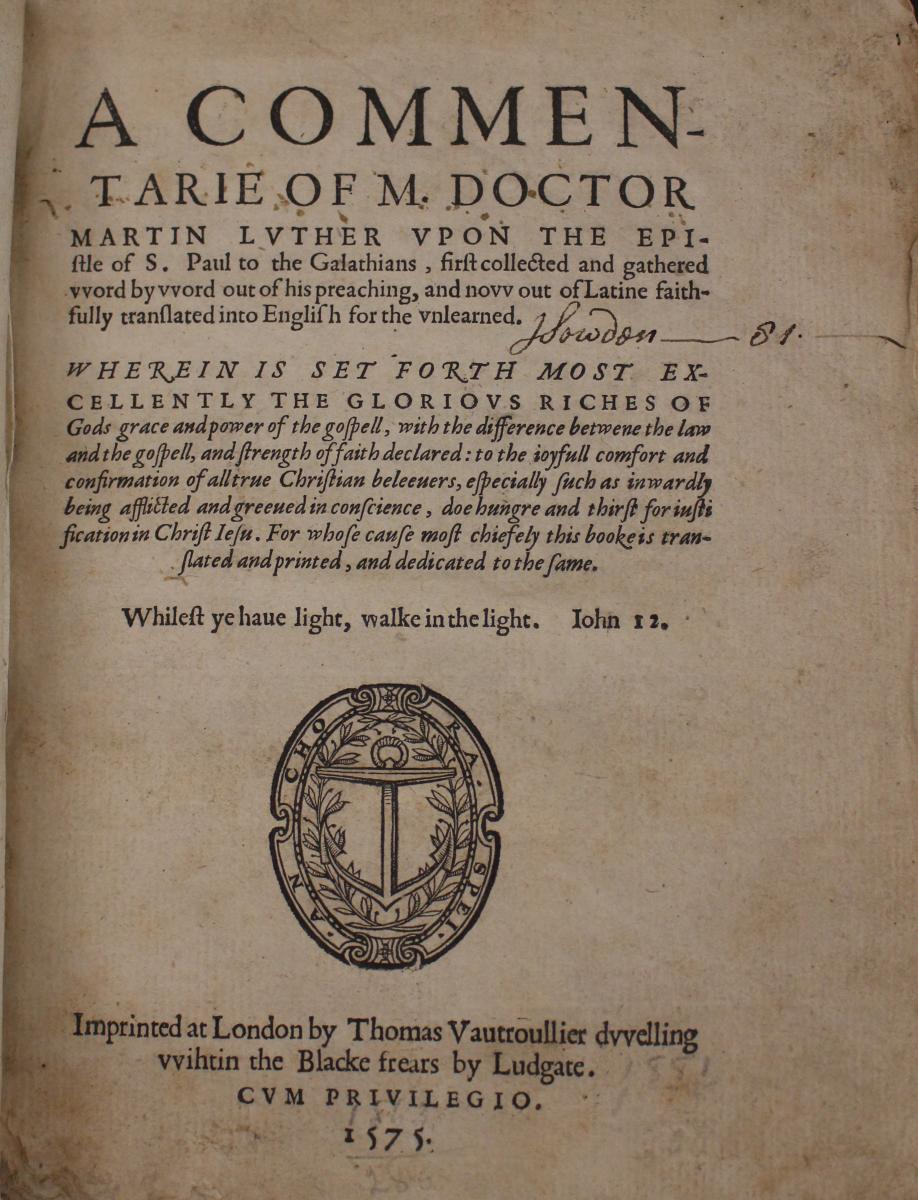
Author: Martin Luther (1483-1546)
A commentary of M. Doctor Martin Luther upon the Epistle of S. Paul to the Galatians, first collected and gathered word by word out of hiss preaching, and now out of Latin faithfully translated into English for the unlearned
London: T. Vautroullier, 1575
Adoption Price: $500
ADOPTED!
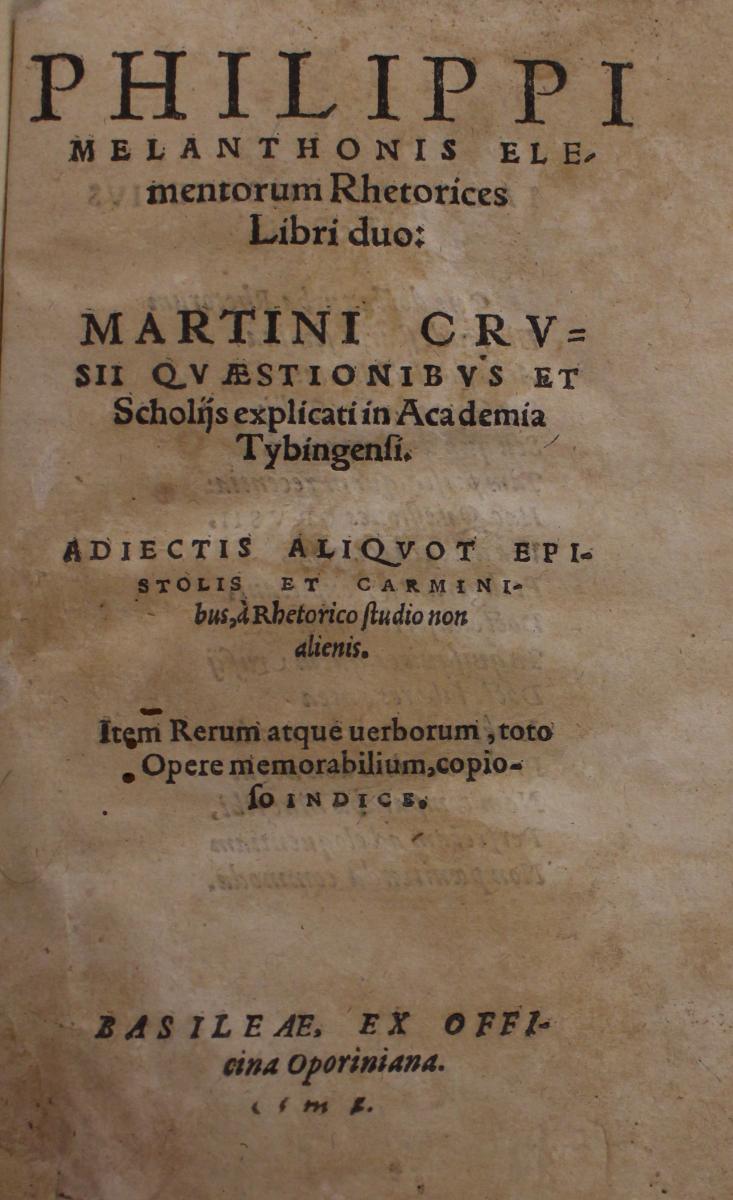
Author: Philip Melanchthon (1497-1560)
Philippi Melanthonis Elementorum rhetorices libri duo / Martini Crusii quaestionibus et scholijs explicati in Academia Tybingensi ; adiectis aliquot epistolis et carminibus, à rhetorico studio non aliensis ; item rerum atque uerborum, toto opere memorabilium, copioso indice
Basileae : Ex officina Oporiniana, Anno salutis humanae MDLXXIIII, mense Martio [1574]
Adoption Price: $250
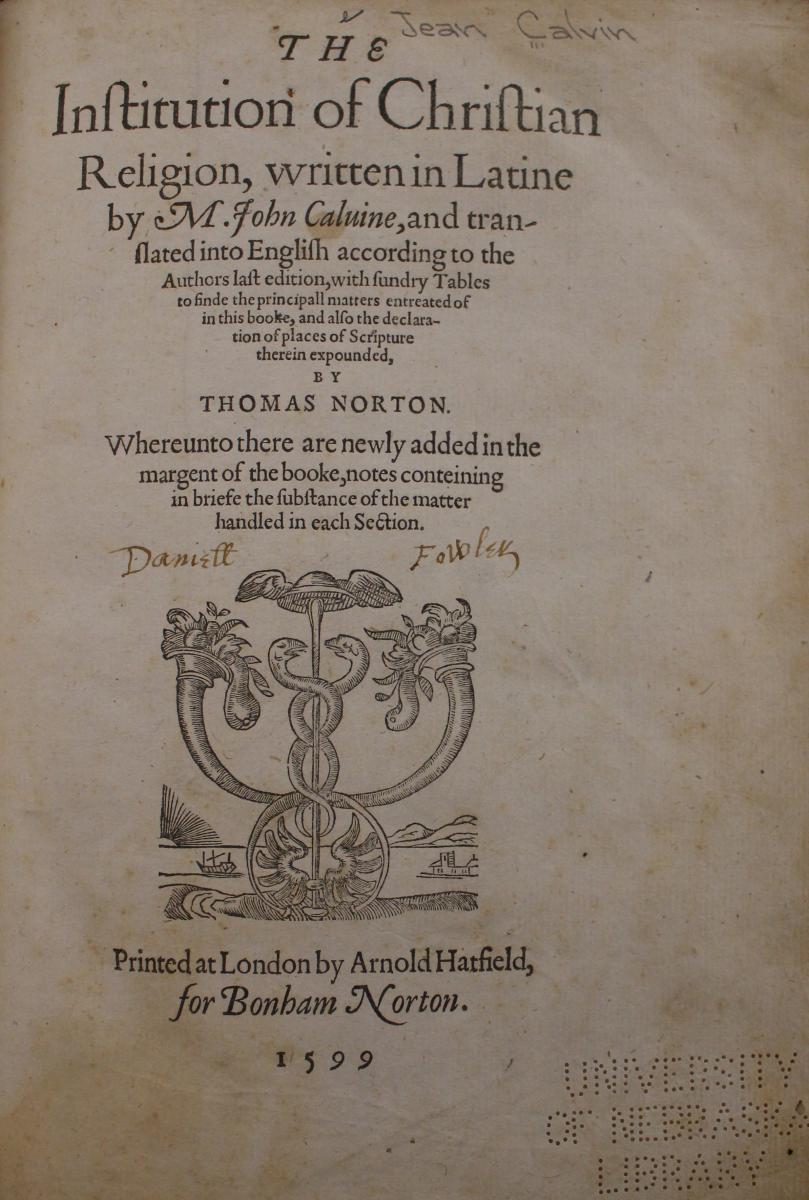
Author: Jean Calvin (1509-1564)
The institution of christian religion, written in Latine by M. John Caluine, and translated into English according to the authors last edition ... by Thomas Norton
London, printed by Arnold Hatfield for Bonham Norton, 1599
Adoption Price: $500
Jonathan Swift (1667-1745)
The advantages proposed by repealing the sacramental test, impartially considered / by the Rev. Dr. Swift ... ; to which is added, "Remarks on a pamphlet entitled 'The nature and consequences of the sacramental test consider'd, with reasons humbly offer'd for repeal of it'"
[London] : Dublin printed, London re-printed for J. Roberts ..., 1732
Adoption Price: $100